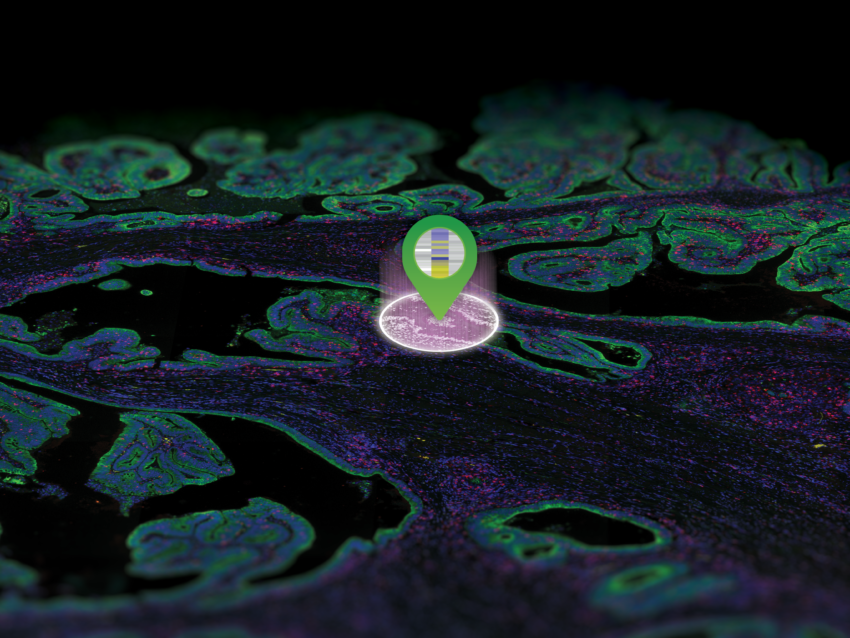
The GeoMx® Digital Spatial Profiler is Aiding Global Infectious Disease Researchers to Reveal How the Immune System Responds to HIV
Imagine a world without HIV
The innate immune response is the first line of defense against the pathogen during a viral infection. Only later the adaptive immune response develops in a long-lasting and precise manner, sustained by memory CD4+ T cells. However, when CD4+ cells are the target of the virus and get destroyed, there is very little defense against the pathogen.
During HIV infection, the virus enters the lymphocytes, where it actively replicates, leading to a high viral load that will eventually destroy the cells and decline their numbers. Infected individuals become immune-compromised and susceptible to opportunistic infections. For decades this global infectious disease has been a major cause of death in rich and poor countries.
Sadly, sub-Saharan African countries hold the highest prevalence of HIV infections due to limited access to health care services and information. The good news is that more scientists are committed to stopping this pandemic, and we had the honor to meet one of them.
Originally from Zambia, Dr. Zaza Ndhlovu moved back to South Africa, the epicenter of the HIV epidemic, with the ultimate goal of seeing the day when HIV is a minor problem in people’s day-to-day lives in the region.
“When I was in high school, many people were dying, close friends, and relatives,” said Ndhlovu. “It affected all of us. My research focus was not on HIV during graduate studies, but it was always on the back of my mind.”

“When I learned about the GeoMx Digital Spatial Profiler, I was excited. GeoMx combines the best of two worlds. You retain spatial info and get info about tissue transcription and protein expression, giving us much more power to understand complex immuno-pathologies, opening up opportunities for a more in-depth understanding of disease processes in tissues.”
Dr. Zaza Ndhlovu, Ph.D.
Ndhlovu received his Ph.D. in Molecular Microbiology and Immunology from Johns Hopkins University and postdoctoral training at Harvard University. While at Harvard, he studied CD8+ T cell responses in a rare and unique group of individuals capable of spontaneous HIV suppression without antiretroviral therapy – called ‘elite controllers.’ He then secured a faculty position at Harvard University (Ragon Institute of MGH, MIT, and Harvard) and decided to establish his research program in South Africa.
Now, Ndhlovu runs a research program at the Africa Health Research Institute (AHRI) in Durban, South Africa, geared towards understanding how HIV persists in tissues in the face of suppressive antiretroviral therapy (ART).
He uses human tissue samples to find where HIV hides in different tissue compartments during treatment. “These studies will contribute to the development of new strategies that could lead to total eradication of HIV from the body,” Ndhlovu said.

Global Infectious Disease Researchers in training!
A pivotal moment in global infectious disease research
With Ndhlovu’s scientific skills and personal passion for contributing to medical issues not being adequately addressed in the African continent, Ndhlovu was compelled to go back to Africa.
“I was away for ten years, and sometimes you begin to forget about some of the problems when you are so far away,” said Ndhlovu. “I always wanted to go back, so when I got the opportunity to set up my lab at AHRI and began interacting with clinicians and coming face-to-face with people infected with HIV, I appreciated the magnitude of the problem. At that point, I decided I would do my part to get this epidemic under control.”
The power of the GeoMx® Digital Spatial Profiler
Traditionally, scientists rely on studying blood samples to understand HIV disease. But since it is clear that HIV is a disease of the tissue, Ndhlovu decided to focus on tissue immunology.
In addition, he wanted to learn more about the site where HIV resided—even when someone was on treatment. This move to studying tissue required Ndhlovu to learn new skills in microscopy to do imaging work to figure out the location of the virus, the affected cells, and immune responses within tissues.
He learned very quickly about the limitations of imaging. He shared, “With imaging, you can understand diseased tissue and see the immune cells, but you cannot figure out what the cells are doing.” So, Ndhlovu tried other approaches; he isolated single cells and did transcriptomics to understand tissue signaling pathways and tissue biology. But he would still miss spatial information.
Then with a generous grant from the Bill and Melinda Gates Foundation, he was able to purchase his first GeoMx DSP.

Young Researchers in the Lab
“When I learned about the GeoMx Digital Spatial Profiler, I was excited,” said Ndlovu. “GeoMx combines the best of two worlds. You retain spatial info and get info about tissue transcription and protein expression, giving us much more power to understand complex immuno-pathologies, opening up opportunities for a more in-depth understanding of disease processes in tissues.”
GeoMx DSP enables researchers to characterize tissue morphology to rapidly and quantitatively profile RNA and proteins in various sample types, including FFPE tissue sections. And the AHRI is now the proud owner of the first GeoMx DSP in the African continent.
“To tackle HIV, a very complex disease, scientists need advanced, innovative tools, and the GeoMx is just that,” said Ndlovu. “The technology plays a critical role in helping understand the tissue and where the virus resides, knowing its precise hiding place within cells. In addition, with GeoMx, scientists can learn why the immune system fails to remove diseased cells, ultimately leading to therapies that could potentially eliminate all infected cells in the body.”
Becoming a Center of Excellence
Growing up as a curious boy from Africa, Ndhovu hopes to open new doors for the next generation of scientists. He has aspirational goals to have his lab at AHRI become a GeoMx Center of Excellence where the equipment can be used to address African problems beyond HIV.
In the meantime, he serves as a bridge, collaborating globally and locally, and takes great pride in providing innovative technology and training to the many young, talented people on his continent.
“To me, success is reaching a day where HIV is a minor problem in our day-to-day life. Achieving prolonged remissions, where HIV infected individuals can go off therapies for months without needing to take meds each day is very much achievable in the near future.”
Join us in this webinar, where we showed Dr. Zaza Ndhlovu and his team the capabilities of NanoString Technologies.

Prof. Zaza and the GeoMx DSP
Africa Health Research Institute
The Africa Health Research Institute’s vision is optimal health and well-being of under-resourced populations. To learn more about AHRI, visit https://www.ahri.org/about/.
Anatech
NanoString operates in South Africa via our distributor Anatech: http://anatech.co.za/
For Research Use Only. Not for use in diagnostic procedures.

Related Content



